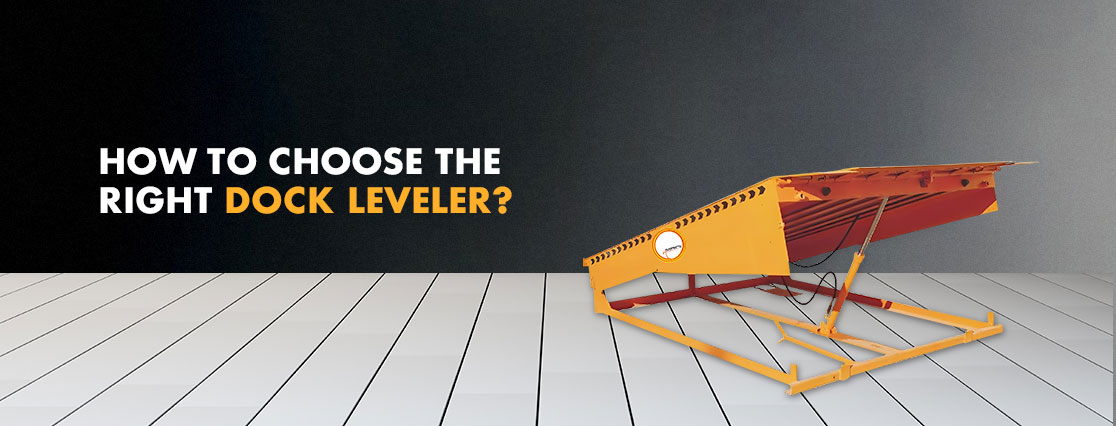How To Choose the Right Dock Leveler?

Dock levelers eliminate the hassle associated with loading and unloading while making the process efficient, damage-free, and safe. Nowadays, choosing an appropriate dock leveler for your facility has become much more complex. With the introduction of new models, a lot of different vehicles are now able to make use of the loading bays. When planning your loading bay, choosing the right dock leveler is crucial for efficiency and safety, keep reading to know more.
What is a Dock Leveler?
The simplest description for this machine is that it connects the loading bay with the vehicle that's docked. Thus, it is a very useful tool that makes the workplace safer for your employees. Of course, it is a useful tool as long as it's correctly aligned with the dock and to the goods one wants to load.
That’s why we recommend conducting an in-depth survey before choosing the right heavy-duty dock leveler for you. This includes assessing the kinds of trucks you’ll be receiving, the internal transport vehicles in use, and all the goods being loaded.
Types of Heavy-Duty Dock Levelers
It is wise to understand the different types of dock levelers to determine which one best suits your business. Every loading dock and vehicle is different. For this reason, there is no such thing as the right dock leveler for every situation.
- Swing Lip - The swing lip dock leveler is mainly used in systems where standard vehicles operate, facilitating safe unloading with minimal downtime.
- Telescopic Lip - With the telescopic lip dock levelers, you just bridge a larger connection surface between the dock leveler and the loading floor. Owing to the extremely precise positioning, the load and unloading process can take place very safely.
- Manually Operable - Ordinarily, no space for a traditional dock leveler? No way! By using the manually operated dock leveler, loading and unloading can still be carried out economically and reliably. The dock leveler is easy to use and very energy-efficient because no power source is required.
- Combi Dock Leveler - It is known for flexibility. This is because the leveler can be used for vans as well as large trucks. This avoids the unnecessary use of many levelers.
- Van-Dock leveler - The growth of e-commerce has introduced a new level—the van dock leveler. Using this, the dock leveler is customized to your situation, weight required for the leveler to carry, and distance in height to bridge.
This shows site-oriented specification of the dock leveler, taking into consideration both the load to be borne and the heights to be crossed by the leveler.
Dock Leveler Length
The dock leveler length is determined based on the maximum gradient allowed for internal transportation and the height of the goods being loaded. If there is a considerable difference in height between the vehicle and the loading bay, then a longer dock leveler is required. Prior consideration should be given to the type of transport being considered according to its maximum angle of gradient of the dock leveler.
Dock Leveler Width
The width of the dock leveler is determined according to the dimensions of the truck, the type of goods to be loaded, and the internal transport equipment being used. In most cases, we would advise selecting the widest dock leveler possible for the application for which it will be used, since this will help with the positioning of the load. Particularly so in situations where the loading may be needed below platform level, and the limited space available on the platform is defined by the pit edges.
Dock Leveler Load Capacity
Load capacity plays an important role in selecting the correct dock leveler. An improper selection with respect to loading capacity may result in accidents. To estimate the required loading capacity, one needs to know the gross train weight which includes the weight of transport, the driver and the load.
Under what conditions would higher load capacity be necessary?
- Driving at a high speed with instant braking
- High frequency of operations
- Palettes with tiny wheels
Wrap Up
A heavy-duty dock leveler is crucial to ensure efficiency and safety in your warehouse. While choosing the best dock leveler for your warehouse, it is important to identify your specific needs and requirements. A suitable dock leveler is determined by the types of vehicles used, goods that are being transported, and loading conditions inside the facility. Considering the length, width, and load capacity are factors to ensure proper operations.
Heavy-duty dock levelers boost productivity and minimize downtime while reducing the risk of injury. Whether you use a swing lip, telescopic lip, or manual dock leveler, it's essential to choose one that seamlessly fits your workflow. Assess your loading dock's configuration and select a heavy-duty dock leveler that enhances efficiency and keeps operations running smoothly. A little planning goes a long way!



